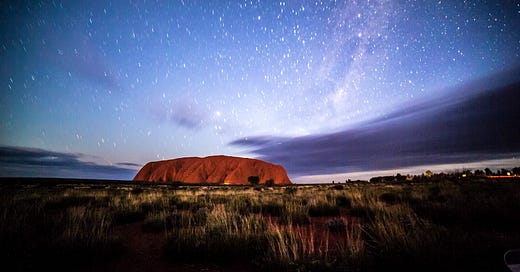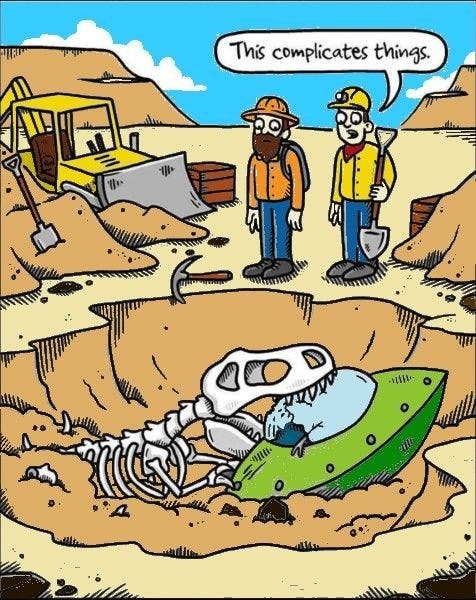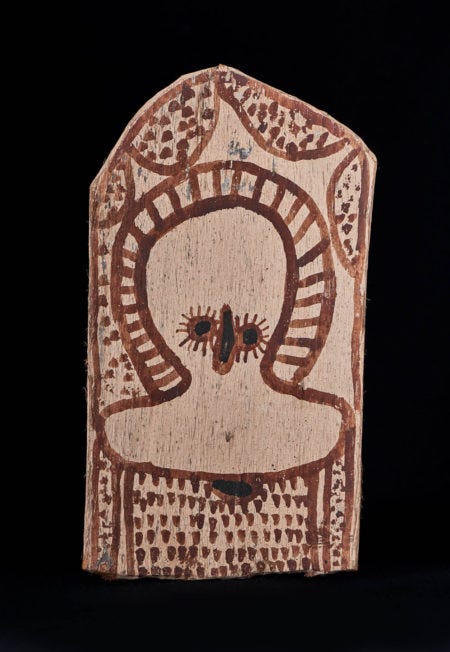Is Extraterrestrial Technology Hidden in the Archaeological Records?
[1] - Indigenous Australians are Custodians of an Alien Sentinel Probe
That’s a wild-sounding header, right? Honestly, though, I’m convinced that the Aboriginal people of Australia are in possession of ancient alien technology. If you are willing to hear me out, I’ll share why I hold that conviction.
Have you watched the Joe Rogan podcast? Like him or hate him, probably you are familiar with Rogan’s super popular show. If you haven’t seen Joe Rogan’s interview with Bob Lazar, episode #1315, there’s a short segment I’d love you to see at timestamp 1:13:50.
Bob Lazar is internet famous for being a self-claimed whistle-blower from a secret government project. Lazar alleged the military had acquired several alien craft. His team of scientists at Area 51 had been tasked with reverse engineering the extraterrestrial technology.
Unsurprisingly the claims made by Bob Lazar have widely been viewed as either a baseless conspiracy theory or a disinformation campaign. Many aspects of the story have been discredited so it should be viewed with intense scepticism. However, there’s really no way to prove or disprove his claim about these crafts.
The one part of Lazar’s story that should give us pause for thought is his opinion on how the alleged alien craft came into the hands of the US military. We might expect him to say that it involved the infamous Roswell UFO crash or another popular ufology alien craft recovery story. He doesn’t.
Just in case you are unable to visit the original interview let me just share the text from that exchange between Rogan and Lazar:
Joe Rogan: “Have you ever asked anyone that has any inkling of any idea of where they got them or how they got them?”
Bob Lazar: “No, but um something must have been said to me from Barry and but I, it was just too long ago and I, I can't quite remember what was said but it just left a seed in my mind. I think at least one of them was part of an archaeological dig. So, it's old, something, at least one of them is old. I don't know if it was the one, I worked on, but I remember something to do with an archaeological dig.”
Joe Rogan: “Whoa.”
Bob Lazar: “So, that uh, that means it's not just old, it's ancient.”
Joe Rogan: “That would be a great Steven Spielberg movie.”
The Discovery of an alien craft in an archaeological dig certainly would make a great movie plot. We can just picture a surprised archaeologist staring slack-jawed at a freshly excavated rock face in which is embedded a Tyrannosaurus with a gleaming metal saucer clenched between its stony jaws. Strange as it sounds this unlikely scenario is more in line with scientific expectations than having an alien craft crash during the last century. A quick journey into space can better explain this conundrum.
Light years away in the Orion Nebula, millions of years in our past, intelligent kangaroo-like beings look up into the vast darkness. Under the purple skies of their world, orbiting its twin suns, they erect gleaming towers of crystal. From these shimmering antennae, they beam a message out into space in the hope of contacting friends from beyond the stars.
Now closer to home, in the system of Proxima Centauri, a team of bluish, eight-limbed humanoids are watching the launch of a rocket. The craft is not unlike those of our own space program. High above in the capsule, their colleagues wave goodbye. Sadly, for them, there’s a serious system error soon after leaving the atmosphere and the craft’s life support systems fail. The ghost ship accelerates away into the depths of space.
Long after the civilization in Orion blew itself to bits in a senseless global conflict, their friendly invitation races outwards at the speed of light. The skeleton-crewed exploration ship from Proxima Centauri continues its silent voyage many millennia after the home world suffered sterilisation during an unfortunate stellar eruption.
Here on Earth scientists involved with the search for extra-terrestrial intelligence (SETI) might use radio astronomy technologies to detect that ancient signal from Orion. NASA’s remote sensing technologies could scour the dark side of our moon and image the crumpled metal frame of the wrecked rocket from Proxima Centauri.
The reality is that SETI is primarily an archaeological enterprise. Scientists hope to sift through the vast past of the universe and find indications that we were not the first beings to look out into the inky blackness of space and dream of touching the distant points of light.
To better appreciate why SETI is focussed on exo-archaeology rather than attempting to contact our space brothers, let’s take a little fishing trip.
We set out to catch a rare type of fish. Arriving at the seashore we put out nets and cast a baited line. After an hour of impatient waiting, we check our line and nets, finding nothing. Should we conclude that our prize simply can’t be caught?
A more reasonable conclusion from our failed attempt would be that we have either chosen the wrong location, used incorrect equipment or allowed too little time. The chances of finding a rare fish in just an hour are extremely low.
The next day after our failure we sail out into the ocean on a large professional fishing boat that’s equipped with helpful modern technologies. For the next six months, we scour the ocean. Finally, we catch the prized rare fish.
All these factors, location, equipment and time, are important for a successful search. Whether we be fishing or searching for extra-terrestrial intelligence, it is the increase in duration that cuts the odds most dramatically.
Most space scientists consider it reasonable to assume that several advanced extra-terrestrial civilizations have arisen in our section of the Milky Way since the dawn of time. If some of these civilizations explored the cosmos using probes it is possible some passed this way. The statistical chances that an alien technology visited our solar system during the last 4.5 billion years are clearly far greater than just during the last 4.5 years.
Space-time is like a vast ocean. We need to mount an extensive search if we wish to detect rare cosmic phenomena. For this reason, space scientists interested in alien technosignatures believe it is far more likely we will find ancient defunct technologies in our solar system than experience aliens arriving from deep space. It is the math behind this philosophical pondering that leaves scientists highly sceptical of claims some UFO sightings are alien spaceships.
Returning to Bob Lazar’s story for a moment, we can now appreciate why his account of a craft found in an archaeological setting actually adds a little credibility. That said, mathematical calculations do not dictate veracity. Some events that happen defy all projected odds.
Hopefully, we can now agree that it makes sense to carry out an archaeological search for alien technologies on earth. The most obvious starting point is the existing scientific and anthropological literature. It is entirely possible evidence of extraordinary things gets overlooked in studies with a particular focus.
It would also make sense that if aliens are genuinely in our skies today, interacting with a few of us, that they didn’t arrive only recently. Evidence of aliens here in the present would suggest an ancient arrival just as the discovery of extra-terrestrial visitation in prehistory would support claims of ongoing interaction.
It’s my understanding that in remote prehistory an alien probe ended up on this planet. That for thousands of years this crucially important artefact has been in the hands of the custodians of earth’s longest-enduring culture.
Bracewell Sentinel Probes
In 1960, professor Ronald Bracewell of Stanford’s radio science laboratory published an important paper titled Communications from Superior Galactic Communities. Bracewell suggested that technologically advanced civilizations would send out exploratory probes, which could orbit numerous stars monitoring over long periods. Further, contact between civilizations would lead to collaborative efforts to further expand the community. Over hundreds of thousands of years a galaxy-wide network of probes could be engineered.
Professor Bracewell had the ingenious thought that alien probes might be in some way autonomous. This was of course long before we developed artificial intelligence and autonomous drones.
“…it would be commensurate with the effort of delivering a material probe into our solar system if the very first probe sent here contained a quite elaborate store of information and a complex computer so that it could not only detect our presence but could also converse with us. Such a probe may be here now, in our solar system, trying to make its presence known to us.”
These hypothetical devices have come to be known as Bracewell sentinel probes. Over the last few years, a growing number of scientists have called on the research community to expand SETI efforts to include a serious search for these probes in our solar system. The potential benefits of a search are nothing short of profound. Harvard astronomer Professor Avi Loeb expounded on this theme in his 2020 article for Scientific American, Let’s Search for Alien Probes, Not Just Alien Signals.
Few scientists have written as much on the potential discovery of alien ‘lurker probes’ in our region of space as Dr James Benford of Microwave Sciences. In personal communication Benford kindly supplied me with a paper he had written on this lurker hypothesis. Benford’s paper highlights that for over two billion years Earth has been an interesting target for advanced civilizations due to the detectable oxygen signature. That allows plenty of time for many exploratory probes to come our way.
One of the most tantalising potential revelations that might come from contact with an autonomous AI sentinel probe, beyond an invitation to a galactic network, would be our gaining access to a complete record of terrestrial history. It is likely any such probes would store data on the entire rise of our species.
Over the last few decades, a number of sources have alleged that an alien probe has been detected moving in polar orbit, travelling east to west. Nicknamed the Black Knight satellite, this object was even observed by astronaut Gordon Cooper. An alleged signal from the satellite that included a star chart was decoded by the author and radio ham, Duncan Lunan. Lunan hypothesised that this satellite had been in orbit for around 13,000 years, having arrived from Epsilon Bootis. In a recent study of old astronomical imaging plates, astronomers led by Beatriz Villarroel identified indications of nine mysterious satellites orbiting earth prior to the space age.
The story of the Black Knight satellite and the other indications of strange objects in orbit merits more than a quick summary, but I want to bring this topic closer to home. There is no reason to think that sentinel probes would be exclusively out in space, hiding among asteroids or orbiting planets. It is equally valid to consider the potential for some AI probes to be left on planetary surfaces.
If an alien race wanted to leave open the potential for us to make contact with their sentinel placing it at ground level certainly makes it more accessible. It’s possible that humans have already encountered a sentient alien probe and attained some level of contact. An obscured account of this event appears in the anthropological literature.
The Churinga of Alcheringa
Churinga is a highly sacred object associated with the Arrernte people of Central Australia. Taboo exists around both physically handling and looking directly at these artefacts. Over the years some have ended up on public display, they are typically smoothly carved oval stones a few inches long. Usually, both sides of the churinga are engraved, most often with some combination of concentric circles and other geometric patterns.
The Arrernte's dreaming lore is very complex, but what can be reasonably summarised here is that the first churinga was left by powerful non-human entities in the distant creation time. These alcheringa beings even had a role in the creation of humans and left behind the first churinga. This was no ordinary artefact, actually, it was itself an alcheringa being with an impermeable form that held a living repository of accessible knowledge.
This churinga (possibly there was more than one) was carefully stored in a remote cave. The only people that had access were fully initiated male elders. It was not to be touched or even looked directly upon by anyone but these guardians. People feared and respected the spirit of the churinga so much that they naturally kept their distance anyway. Over the millennia copies were made and these were considered just as sacred as the original/s.
A living artefact left by powerful beings in remote prehistory, a repository of great knowledge that can be accessed by at least some people. It certainly sounds a lot like a Bracewell sentinel probe. For me, the confirmation came only after hearing the account of two people that came into contact with this artefact. One of these persons was an Aboriginal elder and the other was a gifted healer of European descent.
The story of the interaction with the artefact is mind-blowing. What emerged is a detailed account of our prehistory involving the arrival of the artefact’s creators. The information takes us back almost eight hundred thousand years, to the beginning of the Homo sapiens lineage. Most crucially, the account provided sufficient details for cross-referencing with objective scientific discoveries. My eventual finding was that the data supported the events being legitimate occurrences. That we had visited and communication technology left behind.
Now the unenviable role of messenger falls upon my shoulders. I will do my best to share the full details of the original encounter, relevant dreaming lore, the data transferred and results from my subsequent years of investigation. If you are starting to suspect the legitimacy of this case please be prepared for some mind-blowing implications. There is much more to be shared.
It's taken me years to process everything involved.
This newsletter is made possible through the kind support of readers, please consider signing up for a paid monthly subscription to help me dedicate my time to better serving this community. Please leave your feedback in the comments!










would love to get your opinion on some of the direct encounters I've had
https://ce5master.substack.com/
I posted on just recently - and there are several more if you scroll through the posts.
Great article, Bruce is a very smart man with a genuine honesty to his writing that captivates. I hope to see more of his work in the future getting media recognition.